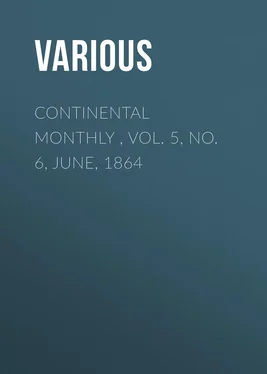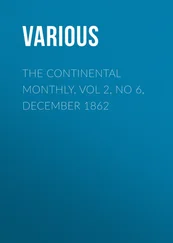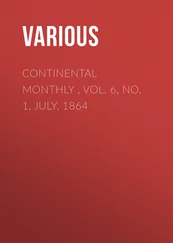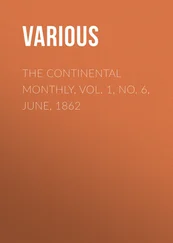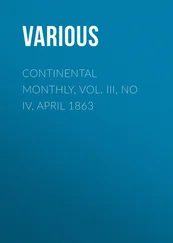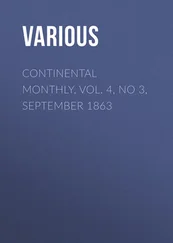Various - Continental Monthly , Vol. 5, No. 6, June, 1864
Здесь есть возможность читать онлайн «Various - Continental Monthly , Vol. 5, No. 6, June, 1864» — ознакомительный отрывок электронной книги совершенно бесплатно, а после прочтения отрывка купить полную версию. В некоторых случаях можно слушать аудио, скачать через торрент в формате fb2 и присутствует краткое содержание. Жанр: foreign_edu, periodic, Политика, на английском языке. Описание произведения, (предисловие) а так же отзывы посетителей доступны на портале библиотеки ЛибКат.
- Название:Continental Monthly , Vol. 5, No. 6, June, 1864
- Автор:
- Жанр:
- Год:неизвестен
- ISBN:нет данных
- Рейтинг книги:3 / 5. Голосов: 1
-
Избранное:Добавить в избранное
- Отзывы:
-
Ваша оценка:
- 60
- 1
- 2
- 3
- 4
- 5
Continental Monthly , Vol. 5, No. 6, June, 1864: краткое содержание, описание и аннотация
Предлагаем к чтению аннотацию, описание, краткое содержание или предисловие (зависит от того, что написал сам автор книги «Continental Monthly , Vol. 5, No. 6, June, 1864»). Если вы не нашли необходимую информацию о книге — напишите в комментариях, мы постараемся отыскать её.
Continental Monthly , Vol. 5, No. 6, June, 1864 — читать онлайн ознакомительный отрывок
Ниже представлен текст книги, разбитый по страницам. Система сохранения места последней прочитанной страницы, позволяет с удобством читать онлайн бесплатно книгу «Continental Monthly , Vol. 5, No. 6, June, 1864», без необходимости каждый раз заново искать на чём Вы остановились. Поставьте закладку, и сможете в любой момент перейти на страницу, на которой закончили чтение.
Интервал:
Закладка:
Professor Riddell also comes to the following conclusions, after an analytic investigation of the sediment. He took one hundred grains from the river margin, dried it at 212° Fahrenheit, before weighing, and found it to contain:
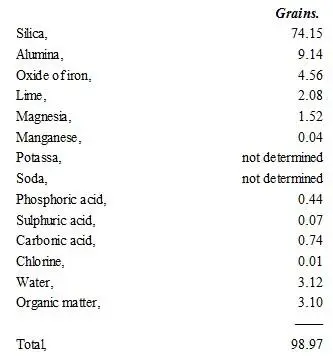
The existence of so large a quantity of sediment in the water of the Mississippi, leads to divers formations in its bed. These formations are principally 'bars' and 'battures.' The banks are also much affected.
When the water of the river, aided by the current, has attained its full capacity of buoyant earth, as we have already said, the excess falls to the bottom. Instead, however, of remaining permanently where it first lodged, which would soon fill up the channel and cause the river to overflow, the scouring of the water on the bottom forces a large portion along with the current, though it be not suspended. Pursuing its course for a while, some irregularity or obstruction falls in the way—a sunken log, perhaps. This obstacle checks the progress of the moving earth—it accumulates; the next wave brings down more—the accumulation becomes greater; until, in the course of a few years, there is a vast field of deposit, and a 'bar' is formed. These 'bars' often divert the channel, and occasion the immense washings before alluded to.
Bars are generally found close to the banks, though there are examples in which they extend in a transverse direction to the current. Bars of this kind very much embarrass and endanger navigation in low water. At Helena, Arkansas, there is an instance of a transverse bar, upon which, in October, the water is less than six feet. These bars are formed of sand, which seems to have been the heavier and less buoyant of the components of the earth thrown into the current by abrasion, the lighter portions having been separated by the water and carried off.
It will not be necessary to consider further the subject of bars in the river, but those at its mouth deserve some attention. The subject is one that has led to much theorizing, study, and fear—the latter particularly, from an ill-founded supposition that they threaten to cut off navigation into the Gulf.
Near its entrance into the Gulf, the Mississippi distributes its waters through five outlets, termed passes, and consequently has as many mouths. These are termed Pass à l'Outre, Northeast, Southeast, South, and Southwest. They differ in length, ranging from three to nine miles. They also all afford sufficient depth of water for commercial purposes, except at their mouths, which are obstructed by bars. The depth of water upon one of these is sufficient to pass large vessels; a second, vessels of less size; and the rest are not navigable at all, as regards sea-going vessels. These bars, too, are continually changing, according to the winds or the currents of the river. It is a rather singular fact that when one of the navigable passes becomes blocked, the river is certain to force a channel of navigable depth through one of the others, previously not in use; so that at no one time are all the passes closed.
In looking into the past, and noticing the changes, it is recorded that in 1720, of all the passes the South Pass was the only one navigable. In 1730, there was a depth of from twelve to fifteen feet, according to the winds, and at another time even seventeen feet was known. In 1804, upon the statement of Major Stoddard, written at that date, the East Pass, called the Balize, had then about seventeen feet of water on the bar, and was the one usually navigated. The South Pass was formerly of equal depth, but was then gradually filling up. (This pass, at present, 1864, is not at all navigated.) The Southwest Pass had from eleven to twelve feet of water. The Northeast and Southeast Passes were traversed only by small craft. Since 1830 the Southwest Pass has been gaining depth. This and Pass à l'Outre are now the only two out of the five of sufficient depth to admit the crossing of the larger class of vessels. The former, however, is the one in most general use. All the other passes, with the exception of the two mentioned, have been abandoned.
In regard to the changes and numerous singular formations at the mouths of the Mississippi, we give a statement made by William Talbot, for twenty-five years a resident of the Balize. He says:
'The bars at the various passes change very often. The channel sometimes changes two and three times in a season. Occasionally one gale of wind will change the channel. The bars make to the seaward every year. The Southwest Pass is now the main outlet used. It has been so only for three years, as at that time there was as much water in the Northeast Pass as in it. The Southeast Pass was the main ship channel twenty years ago; there is only about six feet of water in that pass now; and where it was deepest then, there are only a few inches of water at this time. The visible shores of the river have made out into the Gulf two or three miles within my memory. Besides the deposits of mud and sand, which form the bars, there frequently rise up bumps, or mounds, near the channel, which divert its course. These bumps are supposed to be the production of salt springs, and sometimes are formed in a very few days. They sometimes rise four or five feet above the surface of the water.' He 'knew one instance when some bricks, that were thrown overboard from a vessel outside the bar, in three fathoms of water, were raised above the surface by one of these banks, and were taken to the Balize, and used in building chimneys. In another instance, an anchor, which was lost from a vessel, was lifted out of the water, so that it was taken ashore. About twenty years ago, a sloop, used as a lighter, was lost outside the bar in a gale of wind; several years afterward she was raised by one of these strange formations, and her cargo was taken out of her.'
We may say the bumps of which Mr. Talbot speaks are termed 'mud bumps,' from the fact of being composed of sediment. They present a curious spectacle as seen from a passing steamer. They are undoubtedly the result of subterranean pressure, but from what cause, whether volcanic, or the influence of the sea or river, or both, has not been determined. Many speculations have been entered into in regard to these phenomena, but as yet without fruitful result.
Leaving this digression, we proceed to notice that the theories set up to explain the causes of the bars at the mouth of the river, have been numerous and various. Some suppose them to be the result of the water of the river meeting the opposing force of the Gulf waves, checking the current, and causing a precipitation of the suspended sediment. Others are of the opinion that the bars are entirely the effect of marine action, and endeavor to show that the immense inward flow of the Gulf washes up from its bed the vast accumulations that are continually forming in the way of navigation.
After a personal observation and investigation, and as well after frequent and free consultation with others, we are persuaded to discredit the above-mentioned theories. The resistance of the Gulf does not form the bars, though it exerts an influence. The immense volume and force of water ejected from the river receives no immediate repellent action from the Gulf, but extends into it many miles without the least signs of disturbance, as may be plainly discovered even in the most casual observation. It is known as well that the water of the river remains perfectly palatable at a very close proximity to the sea. This is a very good evidence of the superior force of the river's current. The two volumes of water mix a considerable distance out at sea.
An able engineer states that, upon examination, he found a column of fresh water seven feet deep and seven thousand feet wide, and discovered salt water at eight feet below the surface. As the result of his investigations, he divides the water into three strata, as follows:
Читать дальшеИнтервал:
Закладка:
Похожие книги на «Continental Monthly , Vol. 5, No. 6, June, 1864»
Представляем Вашему вниманию похожие книги на «Continental Monthly , Vol. 5, No. 6, June, 1864» списком для выбора. Мы отобрали схожую по названию и смыслу литературу в надежде предоставить читателям больше вариантов отыскать новые, интересные, ещё непрочитанные произведения.
Обсуждение, отзывы о книге «Continental Monthly , Vol. 5, No. 6, June, 1864» и просто собственные мнения читателей. Оставьте ваши комментарии, напишите, что Вы думаете о произведении, его смысле или главных героях. Укажите что конкретно понравилось, а что нет, и почему Вы так считаете.
